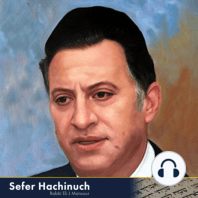20 min listen
Misva #330: Counting the Years Until the Yobel (Jubilee)
FromSefer Hachinuch
ratings:
Length:
20 minutes
Released:
Nov 24, 2022
Format:
Podcast episode
Description
The Torah commands in Parashat Behar (Vayikra 25:24), “Ve’safarta Lecha Sheba Shabetot Shanim” – that we are to count seven series of seven years, meaning, forty-nine years, and then declare the fiftieth year as the Yobel (“jubilee”) year. Every seven years, the Shemita year is observed, and agricultural activity is forbidden during that year. The Torah commands counting seven Shemita cycles, each year for forty-nine years, and then proclaiming the fiftieth year sacred. During the fiftieth year, agricultural work is forbidden as it is during Shemita. In addition, servants are released, and properties are returned to their original owners. This obligation to count the years until Yobel is assigned specifically to the Sanhedrin. The Sefer Ha’hinuch explains that G-d commanded us to observe the Yobel year so we are reminded that ultimately, everything in existence belongs to G-d. Servants are released and sold lands are returned to their original owners to demonstrate that Hashem is the true owner over everything on earth, and He decides who receives what. By counting every year in relation to Yobel, the Sefer Ha’hinuch writes, we become mindful of this fundamental tenet, and this will, in turn, deter us from theft and from coveting our fellow’s possessions. Once we realize that everything belongs to Hashem, and He gives each person all that he has, we will recognize the futility of obtaining things in a way which Hashem forbids, because we will understand that Hashem will take away from us anything we were not supposed to take. Additionally, the Sefer Ha’hinuch writes, this Misva reflects a “Sod” (“secret”) relating to the number of years that the world as we know it will exist, before the period of Mashiah and the establishment of a new world order. Tradition teaches that this counting – like the Sefirat Ha’omer counting from Pesach until Shabuot – must be done verbally. This is in contrast to the counting of the Zab and Zaba (people who experienced certain types of bodily emissions that render them impure), who must count seven “clean” days without emissions. This counting requires not a verbal statement of the number of days, but rather simply keeping track of the days. By contrast, the counting of the years until Yobel requires the Sanhedrin to make a verbal pronouncement. The Torah uses the same verb in both these contexts (“Ve’safarta Lecha,” and “Ve’safar”/”Ve’safra”), but nevertheless, our oral tradition teaches that the command in the context of Yobel requires a verbal counting, and the command in the context of the Zab and Zaba does not. The Sefer Ha’hinuch notes that there are other examples of this phenomenon – of a command formulated identically in different contexts, but interpreted differently in each context. For example, the Torah commands us to remember (“Zachor”) Amalek’s attack, the Exodus from Egypt, and Miriam’s leprosy. However, in the first two contexts, this refers to verbally recalling the event, whereas in the case of Miriam, we need to remember the event in our minds, without verbally mentioning it. These different interpretations have been handed down to us through our oral tradition. The Sefer Ha’hinuch in this context discusses the debate among the Rishonim regarding the Shemita cycle. It is accepted that the year before the destruction of the second Bet Ha’mikdash was a Shemita year, but there is disagreement as to when this calamity occurred. Rashi, as the Sefer Ha’hinuch cites, maintained that the destruction occurred in 3828 (68 C.E.), such that the year 3827 was a Shemita year. According to this view, the Sefer Ha’hinuch writes, it emerges that the year 5017 (1256-7), which was during the Sefer Ha’hinuch’s lifetime, was a Shemita year. Rabbenu Hananel, however, was of the opinion that the destruction took place in 3829 (69 C.E.), such that 3828 was a Shemita year, and in the Sefer Ha’hinuch’s time, 5018 (1257-8) was a Shemita year. Interestingly, the accepted opinion is that the destruction oc
Released:
Nov 24, 2022
Format:
Podcast episode
Titles in the series (100)
Misva #11: The Prohibition Against Having Hametz in One’s Possession During Pesach: Daily Sefer Hachinuch - Brought to you by itorah.com by Sefer Hachinuch
